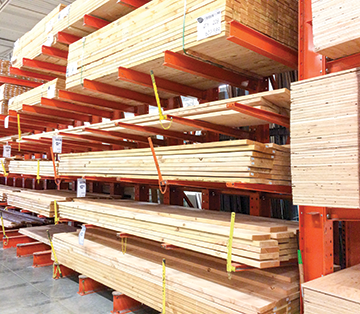
|
With ongoing shortages of building materials and products, substitutions have become more commonplace—but they can have unintended consequences. One issue that has arisen involves substituting European lumber for North American lumber, a decision that could result in unintended consequences.
The situation
At the start of the COVID-19 pandemic, wood product producers were operating under the same uncertainty as the rest of the world. Many mills curtailed production in anticipation of worker shortages and reduced demand. At the same time, many wholesale and retail lumber customers significantly reduced inventory levels. Also, because of the Great Recession, several mills had closed permanently. The American Wood Council reports between 2007 and 2017, mill closures in the South resulted in a lumber capacity loss between 1.7 to 2 billion board feet. Mill closures in the Pacific Northwest represented 10% of the area’s mills.
Although the demand for wood products had dipped, it quickly rebounded during the pandemic because of increased remodeling projects and new housing starts spurred, in part, by low interest rates. With increased demand and low supply, lumber pricing fluctuated wildly. To offset the low lumber supply, some wholesale and retail lumber customers sought out and imported European lumber.
On June 11, the North Carolina Department of Insurance, which has administrative authority over North Carolina’s building code, issued an alert warning European lumber may not meet the state’s requirements. The primary concern cited was the lower wood density or specific gravity of European lumber may affect the performance of fasteners, resulting in reduced resistance capacities.
Incidentally, a No. 2 grade designation is common for both North American and European produced lumber. However, No. 2 grade European lumber may have a specific gravity less than 0.42, on which U.S. design standards are based.
In June, the Pacific Lumber Inspection Bureau and American Wood Council issued bulletins partially refuting the North Carolina alert and offered additional useful information. U.S. building codes and wood design manuals are based on four major species of wood commonly produced in North America. All known European wood species except one have adequate specific gravity values and should be acceptable based on U.S. building codes and design manuals. The one exception identified by the Pacific Lumber Inspection Bureau is Norway Spruce from Romania and Ukraine, which has a specific gravity less than 0.42 and should not be used for carrying loads without additional engineering.
The American Wood Council issued a supplement to its National Design Standard for Wood Construction providing design values for multispecies, country grade-marked dimensional lumber. Also, the Pacific Lumber Inspection Bureau is developing additional design tables to further assist designers.
This lumber substitution issue likely has no direct effect on lumber used in roof systems, such as dimensional lumber used for wood blocking and nailers. However, it illustrates the potential for problems with material and product substitutions not fully evaluated and documented by individuals knowledgeable of the specific materials and products being considered.
Substitution guidance
In the U.S., most roofing materials and products are required to comply with recognized material or product standards. For example, the International Building Code® and International Residential Code® require most roofing materials and products comply with specific ASTM International standards.
When evaluating roofing material and product substitutions, using the applicable U.S. product standard can provide a useful basis for comparison.
In addition to identifying materials and products by manufacturer and brand name, I encourage suppliers and contractors to identify materials and products by the applicable U.S. product standard in purchase orders and other purchase agreements.
Compliance with specific listing and approvals, such as UL certifications and FM Approvals’ approvals, also can provide a useful basis for comparison.
The IBC and IRC also contain provisions for an authority having jurisdiction (such as a building code official) to evaluate and approve alternative materials and products and methods of application. Additional information about the codes’ alternative evaluation and approval provisions is provided in “Consider alternatives,” April 2019 issue.
MARK S. GRAHAM is NRCA’s vice president of technical services.
COMMENTS
Be the first to comment. Please log in to leave a comment.